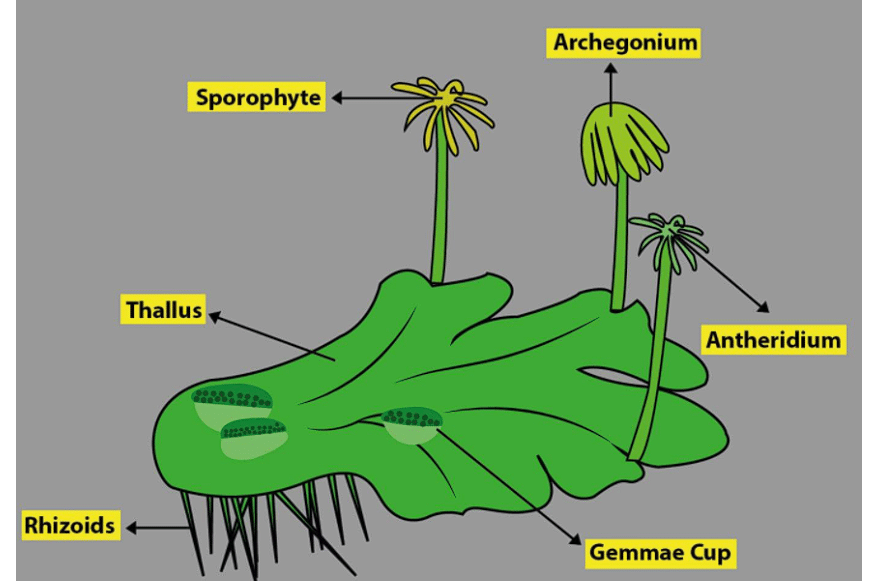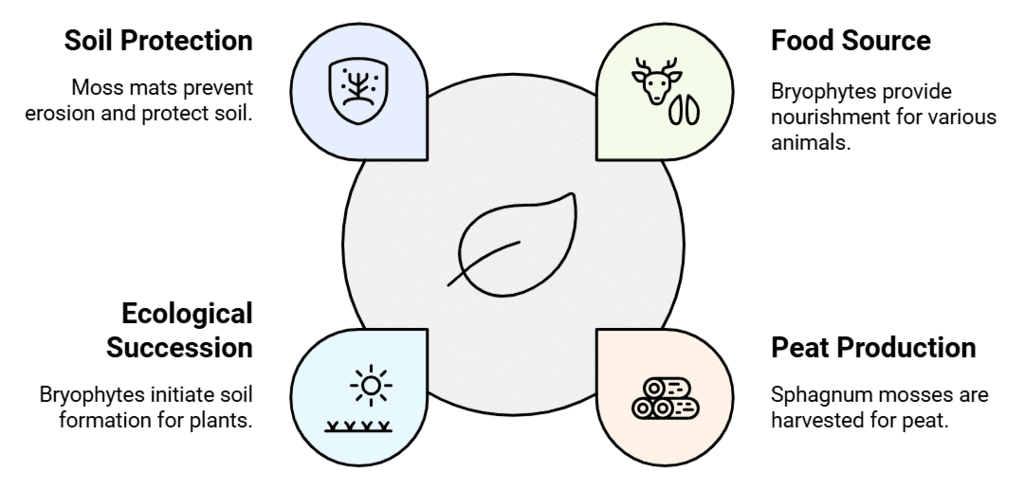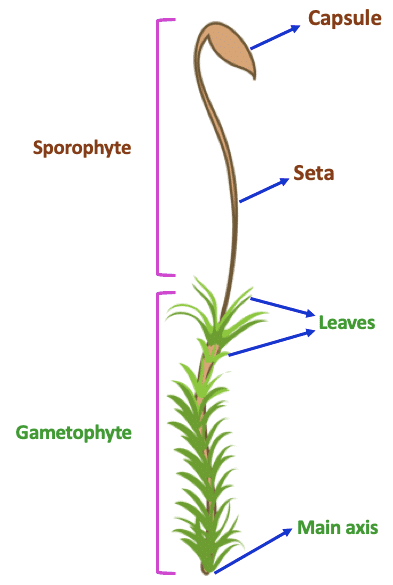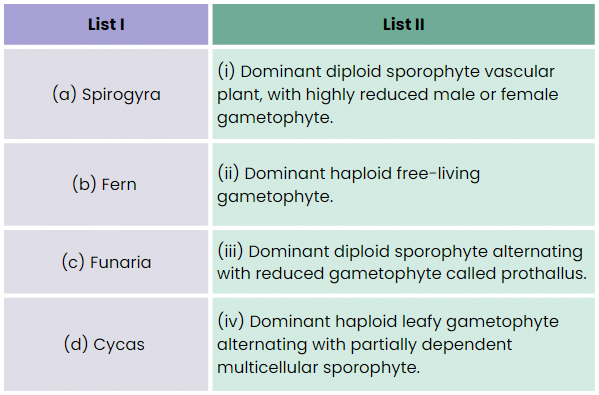Bryophytes | Biology Class 11 - NEET PDF Download
Bryophytes, often referred to as the "Amphibians" of the plant kingdom, are non-vascular plants characterized by the absence of true roots, stems, and leaves. While they primarily grow on land, they require ample moisture for their reproductive processes, making them uniquely adaptable to both dry and wet environments.
What are Bryophytes?
"Bryophytes" serves as an informal collective term for mosses, liverworts, and hornworts. These plants, lacking vascular characteristics like roots and vascular tissue, obtain water and nutrients by absorbing them directly from the air through their surfaces.
 Bryophytes
Bryophytes
Characteristics of Bryophytes
- Bryophytes are the first land plant. It is believed that they originated from aquatic plant and they come on land through water because some bryophytes have characteristics similar to aquatic plants.
Example: Presence of air canal. - Bryophytes are known as amphibians of the plant kingdom because they need water to complete their life cycle. Most bryophytes are found on land.
- Bryophytes are not considered as successful land plants because vascular tissue is absent and they need water for fertilization. Due to the absence of vascular tissue, bryophytes can not grow very tall.
- Roots are absent in bryophytes. The stem and leaves of bryophytes are functionally similar to the stem and leaves of higher plants.
- Bryophytes include the various mosses and liverworts that are found commonly growing in moist shaded areas in the hills
Plant Body and Reproductive Structures of Bryophytes
The plant body of bryophytes is more differentiated than that of algae. It is thallus-like, which means it can be flat or upright, and is attached to the substratum (surface it grows on) by unicellular or multicellular rhizoids.
 Structure of Bryophytes
Structure of Bryophytes
- Unlike true roots, stems, or leaves, bryophytes may possess root-like, leaf-like, or stem-like structures.
- The main plant body of a bryophyte is haploid, meaning it has half the number of chromosomes compared to higher plants. This haploid body produces gametes, or sex cells, and is called a gametophyte.
- The sex organs in bryophytes are multicellular. The male sex organ is called an antheridium, which produces biflagellate antherozoids (sperm-like cells). The female sex organ is called an archegonium, which is flask-shaped and produces a singleegg.
Reproduction in Bryophytes
- Bryophytes, including mosses, liverworts, and hornworts, have unique reproductive strategies that require water for successful fertilization. This is because the sperm-like cells, called antherozoids, need water to swim to the egg and fertilize it.
- Male reproductive organs, called antheridia, produce antherozoids, while female reproductive organs, called archegonia, produce eggs. The antherozoids are released into the surrounding water, where they swim using their flagella. They move towards the archegonia, which are usually located on the surface of the gametophyte plant body.
- When an antherozoid reaches the archegonium, it fuses with the egg, resulting in the formation of a diploid zygote. This zygote is the first stage of the sporophyte, which is the diploid generation of bryophytes. The sporophyte remains attached to the gametophyte and depends on it for nourishment.
Life Cycle of Bryophytes
 Life Cycle of Bryophytes
Life Cycle of Bryophytes
- Once the zygote is formed, it develops into a multicellular sporophyte, which consists of a foot, seta (stalk), and capsule (sporangium).
- The foot is embedded in the gametophyte and absorbs nutrients from it, while the seta elevates the capsule above the gametophyte. The capsule contains spores, which are produced by meiosis (reduction division) in the cells of the sporophyte.
- When the spores are mature, the capsule opens and releases the spores into the environment. These spores are haploid and can germinate into a new gametophyte if they land in a suitable environment with sufficient moisture.
- The spores develop into protonemata, which are thread-like structures that eventually give rise to male and female gametophytes.
Importance of Water in Bryophyte Reproduction
- The need for water in bryophyte reproduction is a key feature that distinguishes them from higher plants.
- The presence of water is essential for the antherozoids to move and fertilize the eggs, as they cannot travel through dry environments.
- This reliance on water for reproduction is one reason why bryophytes are typically found in moist environments, such as damp soil, rocks, or near water bodies.
Importance of Bryophytes
Bryophytes may not have significant economic value, but they play important roles in ecosystems and provide certain benefits. Here are some key points about their importance:

- Food source: Some mosses serve as a food source for herbivorous mammals, birds, and other animals.
- Sphagnum moss: Species of Sphagnum moss are valuable because they provide peat, which has been used for a long time as fuel and packing material for transporting living materials. Peat is prized for its ability to hold water.
- Ecological role: Mosses, along with lichens, are among the first organisms to colonize rocks. This process is crucial for ecological succession, as they help decompose rocks and create a substrate suitable for the growth of higher plants.
- Soil protection: Mosses form dense mats on the soil surface, which helps reduce the impact of falling rain and prevents soil erosion. This protective role is vital for maintaining soil health and preventing land degradation.
Classification of Bryophytes
(a) Liver Worts
All the bryophytes included in this class have a shape like liver, so they are known as liverworts.The plant body of this group is like thallus. Rhizoids and scales are present on the thallus. Rhizoids are unicellular and unbranched. Scales are multicellular.
 Liverwort
Liverwort
Liverworts are simple, non-flowering plants that typically grow in moist and shady environments. Here’s a closer look at their characteristics and reproduction methods:
Habitat: Liverworts are commonly found in moist and shaded areas such as the banks of streams, marshy grounds, damp soil, tree bark, and deep within forests.
Structure
- Their plant body is usually thalloid, as seen in examples like Marchantia. This means they have a flat, leaf-like structure.
- The thallus (the main part of the plant) is dorsiventral, which means it has a distinct upper and lower side, and is closely pressed against the surface it grows on.
- Leafy liverworts have tiny, leaf-like structures arranged in two rows along their stem-like parts.
Asexual Reproduction
- Liverworts can reproduce asexually through fragmentation of their thalli or by producing specialized structures called gemmae.
- Gemmae are small, green, multicellular buds that develop in tiny cups on the thallus. When these gemmae detach from the parent plant, they can grow into new individuals.
Sexual Reproduction
- In sexual reproduction, male and female reproductive organs can be found either on the same thallus or on different ones.
- The sporophyte (the spore-producing stage) consists of three parts: a foot, a seta(stalk), and a capsule.
- Inside the capsule, spores are produced after the process of meiosis. These spores later germinate to form free-living gametophytes
Example: Marchantia is a common type of liverwort that exhibits these characteristics.
(b) Mosses
 Bryopsida
Bryopsida
Moss Life Cycle
- The life cycle of a moss primarily consists of the gametophyte stage, which is divided into two parts.
- The first part is the protonema stage, which grows directly from a spore. This stage is characterized by its creeping, green, branched, and often filamentous appearance.
- The second part is the leafy stage, which forms from the secondary protonema as a side bud. In this stage, the moss has upright, slender stems with spirally arranged leaves, anchored to the soil by branched, multicellular rhizoids.
- The leafy stage is also where the sex organs are located.
- Vegetative reproduction in mosses occurs through fragmentation and budding in the secondary protonema.
- During sexual reproduction, the sex organs, antheridia (male) and archegonia (female), develop at the tips of the leafy shoots. After fertilization, the zygote grows into a sporophyte, which includes a foot, seta (stalk), and capsule. The sporophyte in mosses is more complex than in liverworts.
- The capsule contains spores, which are produced after meiosis. Mosses have a sophisticated mechanism for spore dispersal.
- Common examples of mosses include Funaria, Polytrichum, and Sphagnum.
To practice the questions on the topic "Bryophytes", you just read, attempt the tests given below:
NEET Previous Year Questions
Q1: Given below are two statements : One labelled as Assertion A and the other labelled as Reason R:
Assertion A: The first stage of gametophyte in the life cycle of moss is protonema stage.
Reason R: Protonema develops directly from spores produced in capsule.
In the light of the above statements, choose the most appropriate answer from options given below: (NEET 2023)
(a) Both A and R are correct and R is the correct explanation of A
(b) Both A and R are correct but R is NOT the correct explanation of A
(c) A is correct but R is not correct
(d) A is not correct but R is correct
Ans. a
The predominant stage of the life cycle of a moss is the gametophyte which consist s of two stages. The first stage is the protonema stage, which develops directly from a spore. Capsule of the sporophyte contains spore which gives rise to protonema. Thus, reason correctly explains the assertion.
Q 2: Match the plant with the kind of life cycle it exhibits: (NEET 2022)

Choose the correct answer from the options given below:
(a) (a)-(iii), (b)-(iv), (c)-(i), (d)-(ii)
(b) (a)-(ii), (b)-(iv), (c)-(i), (d)-(iii)
(c) (a)- (iv),(b)-(i), (c)-(ii), (d)- (iii)
(d) (a)-(ii), (b)-(iii), (c)-(iv), (d)-(i)
Ans: d
- Spirogyra is a green alage, haplontic life cycle.
- Fern is a pteridophyte – Life cycle shows dominant diploid sporophyte, alternating with reduced free living gametophytic stage. So its Haplo-diplontic life cycle.
- Funaria – belongs to Bryophyta. Its a moss plant. Exhibits haplo diplontic lifecycle. The free living haploid gametophyte bears the sporophytic plant body.
- Cycas – Gymnosperms. Gymnosperms exhibit dominant diploid saprophytic plant body, with highly reduced male/female gametophyte.
Q 3: Strobili or cones are found in: (NEET 2020)
(a) Marchantia
(b) Equisetum
(c) Salvinia
(d) Pteris
Ans: b
Strobilus is a structure present on many land plant species consisting of sporangia-bearing structures densely aggregated along a stem. Equisetum produces strobili.
|
150 videos|399 docs|136 tests
|
FAQs on Bryophytes - Biology Class 11 - NEET
| 1. What are bryophytes and why are they important in the ecosystem? |  |
| 2. What are the main characteristics of bryophytes? |  |
| 3. How does the life cycle of bryophytes differ from that of higher plants? |  |
| 4. What are the reproductive structures found in bryophytes? |  |
| 5. How are bryophytes classified and what are the major groups? |  |

















